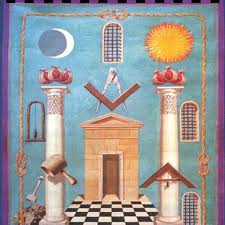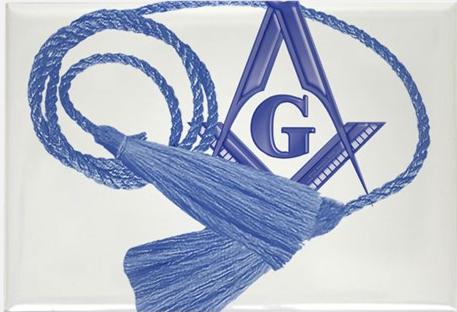The Cable-Tow is purely Masonic in its meaning and use, or so we are told.
(…) In an early pamphlet by Pritard, issued in 1730 the cable-tow is a called a “Cable-Rope” and in another edition : a “Tow-Line.” However in neither pamphlet is the word ever used in exactly the same form and sense in which it is used today. (…) The whole Masonic Lodge is a symbol and every object and every act performed within it , is symbolical. The whole fits together into a system of symbolism by which Masonry veils the truth that it seeks to teach.
As far back as we can go in the history of any initiation, we find the cable-tow, or something similar , used very much as it is used in a Masonic Lodge today. Whether it is called “Khabel” from the Hebrew or “Cabel” from the Dutch (both meaning a rope) the fact is the same. In India, in Egypt and in most of the ancient world , a cord or cable was being used in the same way and for the same purpose.
So far as we can make out, the cable-tow seems to represent some kind of pledge, a vow in which a man pledges his life. We even find the cable-tow being employed outside the initiatory rites. For example, in a striking scene recorded in the Bible (I Kings 20:31,32), the description of which is almost Masonic, “Ben-Hadad” – the King of Syria – had been defeated in battle by the King of Israel and his servants are making a plea for his life. They approach the King of Israel “with ropes upon their heads,” and speak of his “Brother, Ben-Hadad.”
Why did they wear ropes, or nooses, on their heads? 
Possibly to symbolize a pledge of some sort, given in a Lodge or otherwise, between the two Kings, of which they wished to remind the King of Israel. The King of Israel asked: “Is he yet alive? He is my brother.” Then we read that the servants of the Syrian King watched to see if the King of Israel made any sign, and, catching his sign, they brought the captive King of Syria before him. Not only was the life of the King of Syria spared, but a new pledge was made between the two men.
The cable-tow, then, is also the visible symbol of a vow by which a man has pledged his life, or has pledged himself to save another man’s life at the risk of his own. Its length and strength are measured by the ability of that man to fullfil his obligation ; a test of both his capacity and his character.
If a lodge is a symbol of the world and the initiation is our birth into the world (of Masonry) , the cable-tow is not dissimilar from the cord which unites a child to  his/her mother at birth. Just as the physical cord, when cut, is replaced by a tie of love between mother and child, so, in one of the most impressive moments of initiation, the cable-tow is removed, because the Brother, by his oath at the Altar of Obligation, is bound by a tie stronger than any physical cable.
his/her mother at birth. Just as the physical cord, when cut, is replaced by a tie of love between mother and child, so, in one of the most impressive moments of initiation, the cable-tow is removed, because the Brother, by his oath at the Altar of Obligation, is bound by a tie stronger than any physical cable.
The cable-tow is the sign of the pledge of the life of a man. As in his oath he agrees to forfeit his life if his vow is violated, so he pledges his life to the service of the Craft. He agrees to go to the aid of a Brother, using all his power in his behalf, “if within the length of his cable-tow,” which means, if within the reach of his power.
But, let us remember that a cable-tow has two ends. If it binds a Mason to the Fraternity, by the same token it binds the Fraternity to each man in it. Happily, in our days we are beginning to see the other side of the obligation – that the Fraternity is under vows to its members to guide, instruct and train them for the effective service of the Craft and of Humanity.
Control, obedience, guidance – these are the three meanings of the cable-tow. Of course, by Control we do not mean that Masonry commands us in the same sense that it uses force. Not at all ! Masonry rules men as beauty rules an artist, as love rules a lover. It controls us, shapes us through its moral teaching and so it wins obedience and gives guidance and direction to our lives.
What is the length of a cable-tow ?
Some say it is seven hundred and twenty feet, or twice the measure of a circle. Others say that the length of the cable-tow is three miles. But such figures are merely symbolical, since to one man it may mean three miles and to another three thousand miles – or to the end of the earth.
For each Mason the cable-tow reaches as far as his moral principles go and his material conditions will allow. Of that distance each person must be his own judge!
So mote it be.
by Anon
extract from the "short Talk Bulletin" - vol IV March, 1926 N.3
- His Majesty’s Servant , David Garrick Esq – Freemason ? - June 7, 2024
- Influencia de la Masonería en Chile - April 29, 2024
- Pomegranate in Freemasonry – its significance - March 11, 2024

